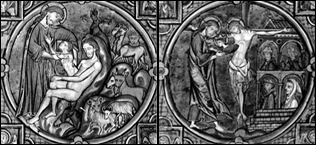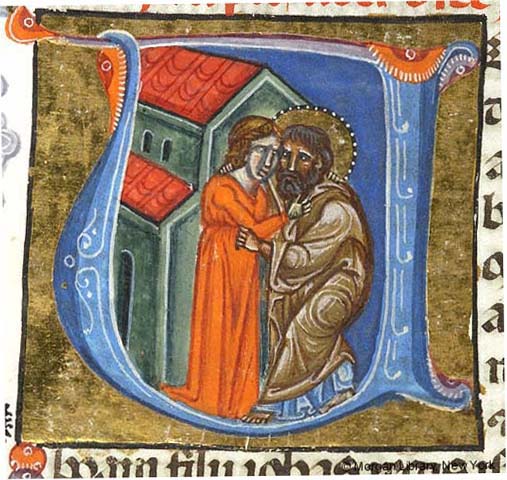 |
|
| |
| Class Prep |
|
|
| |
Marriage in Practice, Myth & Metaphor
 - This class and the next explore the way women are presented in the prophetic books of the Bible. Because the prophets are advising kings and speaking publicly on matters of domestic and international policy, women become figures deployed for rhetorical ends. Marriage, adultery, domestic violence and rape, pregnancy, birth and nurture are applied metaphorically to the relationship with God and to the sin of (male) kings and Israel itself. An example we will focus on today is pictured in the medieval manuscript of the biblical book of Hosea to the right. God requests that the prophet Hosea marry the prostitute Gomer to symbolize the "adultery" of Israel against its covenant partner God.
-
- We’ll examine marriage and divorce in the ANE (Coogan), Hosea’s use of "adultery" as a metaphor for sin, and a third-wave feminist view that situates these texts in the political context of colonization (Carvalho).
-
-
- Assigned Readings
-
- Primary:
- Secondary:
- Michael Coogan, God & Sex, 63-98
- Corrine L. Carvalho, "The Challenge of Violence and Gender under Colonization," in The Hebrew Bible: Feminist and Intersectional Perspectives (ed. Gale A. Yee; Minneapolis: Fortress, 2018) 107-132 (Camino)
- online class prep
- Seminar Leadership Summary and Questions
-
- Slides for Lecture
-
-
- Today's Authors
-
| |
 |
Michael D. Coogan is a lecturer on the Hebrew Bible/Old Testament at Harvard Divinity School, Director of Publications for the Harvard Semitic Museum, editor-in-chief of Oxford Biblical Studies Online, and professor emeritus of religious studies at Stonehill College. He has published an introduction to the Old Testament, and has served as editor of The New Oxford Annotated Bible and The Oxford Encyclopedia of the Books of the Bible. |
| |
 |
Corrine Carvalho is a Professor of Theology and Interim Dean of the School of Social Work at the University of St. Thomas in St. Paul, Minnesota. A specialist on the prophets of the exile and the Deuteronomistic history, she has published several feminist studies of these books examining themes of gender, violence and the historical context of the Babylonian destruction of Israel. |
-
-
- Further Reading
-
- Berman, Sidney K. "Of God's Image, Violence against Women and Feminist Reflections." Studia historiae ecclesiasticae 41:1 (2015) 122-37.
-
- Carvalho, Corrine. "Drunkenness, Tattoos and Dirty Underwear: Jeremiah as a Modern Masculine Metaphor." Catholic Biblical Quarterly 80 (2018) 597-618.
-
- --------. "'Should Our Sister Be Treated Like a Whore?' A Response to Feminist Critiques of Ezekiel 23." In The Book of Ezekiel: Theological and Anthropological Perspectives (ed. John T. Strong and Margaret S. Odell; SBL Symposium 9; Atlanta: SBL, 2000) 221-238.
-
- Carvalho, Corrine and Jonathan Stökl, eds. Prophets Male and Female: Gender and Prophecy in the Hebrew Bible, the Eastern Mediterranean and the Ancient Near East, SBL Ancient Israel and Its Literature. Atlanta: Society of Biblical Literature Press, 2013.
-
- Connolly, Tristanne J. "Metaphor and Abuse in Hosea." Feminist Theology (18 May 1998) 55-66.
-
- Graetz, Naomi. "The Haftarah Tradition and the Metaphoric Battering of Hosea's Wife." Conservative Judaism 45:1 (1992) 29-42.
-
- Keefe, Alica A. "Family Metaphors and Social Conflict in Hosea." In Writing and Reading War: Rhetoric, Gender, and Ethics in Biblical and Modern Contexts (ed. Brad E. Kelle and Frank Ritchel Ames; Atlanta: Society of Biblical Literature Press 2008) 113-27.
-
- Kelle, Brad E. "Hosea 1–3 in Twentieth-Century Scholarship." Currents in Biblical Research 7:2 (2009) 179-216.
-
- Sherwood, Yvonne. The Prostitute and the Prophet: Hosea's Marriaage in Literary-Theoretical Perspective, JSOT Sup 212. New York: T&T Clark, 2004.
-
- Setel, T. Drorah. "Prophets and Pornography: Female Sexual Imagery in Hosea." In A Feminist Companion to the Song of Songs (ed. Athalya Brenner-Idan; Sheffield: JSOT Press, 1993) 143-55.
-
- Wakeman, Mary K. "Biblical Prophecy and Modern Feminism: For George E. Mendenhall." In Beyond Anrocentrism: New Essays on Women and Religion (ed. Rita M. Gross; Missoula, Montana: Scholars Press, 1977) 67-86.
-
-
- Acknowledgements
-
- Image: Gomer and Hosea, in the initial letter of the Book of Hosea in a medieval Latin manuscript of the Bible, Italy, probably Palermo, first quarter of the 14th century;
MS G.60 fol. 473v. Online, The Morgan Library and Museum, http://ica.themorgan.org/manuscript/page/39/76984, accessed 22 January 2020.
|
|
| |
|
|
| | | |
